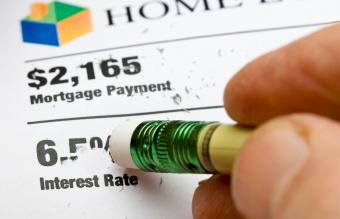
While the mortgage market isn't tied to the Fed's rate, there is a relationship between treasury notes mortgage rates, specifically between 15- and 30-year fixed rate mortgages and the 10-year treasury note. When the yield of the 10-year treasury note drops, the mortgage rate will drop and when the yield of the treasury note rises, the mortgage rates will rise accordingly.
Role of Declining Real Estate Market
There are certain times when this correlation may not hold true; for example, during the recession of 2008-2009, as a direct result of the mortgage crisis. During this period, lenders sought to build higher profit margins into the fewer mortgage deals they did have. This was an attempt to hedge against a declining real estate market and to recoup their losses from the crisis.
This, in turn, made the relationship between treasury note yield and mortgage rates change because normal procedures were not being followed by bankers. During the height of the mortgage crisis, the span between the 10-year treasury note yield and the mortgage rate was as much as 2.75 points.
Affect of Long-Term Economic Indicators
Home loan mortgage rates are influenced by longer-term economic indicators. The Federal Reserve Board's benchmark is the interest rate that banks will charge other banks for overnight loans. It is also tied to the prime lending rate that banks charge their best customers. Short-term variable rate loans are based on this prime rate, such as a home equity credit line.
Overall, lenders take a long-term view when determining rates for the 30-year fixed-rate loan, however. It is for this reason that the 10-year United States Treasury note is a fairly reliable indicator of where rates are going.
Affect of Bad Economy and Bad Economic News
Generally, mortgage rates and treasury yields both drop during bad economic climates or even upon the publication of bad economic news. During "bad" times like these, investors move their funds to investments that are deemed safer, such as Treasury bonds. During good economies or periods of positive economic news, both the treasury yield and mortgage rates might rise. According to the historical data from 1972, during recessions, the spread between the two averaged 199 basis points as compared to 163 basis points in other periods.
Relationship Between Treasury Notes Mortgage Rates
While a finanical expert might tell you that there is technically no correlation between the two (and it would be true), there are any number of people who have been following this pattern for decades who will tell you to "just watch the pattern and connect the dots." The pattern is "10-year treasury note yield drops, mortgage rate drops" and "10-year treasury note yield rises, mortgage rate rises."
Barring abnormal factors (such as the real estate / mortgage crisis of 2008-2009 and resultant hedging by bankers), the pattern appears to hold true. This fact makes the 10-year treasury note yield a fairly reliable general indicator of where current mortgage rates are headed.
Calculations
The Political Calculations Blog has a tool that allows you to input data and it will predict for you where mortgage rates are going based on the current treasury notes yield. This is fun to use and can be very helpful if you are in the market to buy a home.
At Calculated Risk, you can view a graph which shows the history of the relationship between treasury notes mortgage rates since April of 1971. Based on the historical data presented, a 10-year yield at 3.84% would suggest a 30-year mortgage rate of around 5.75%.







